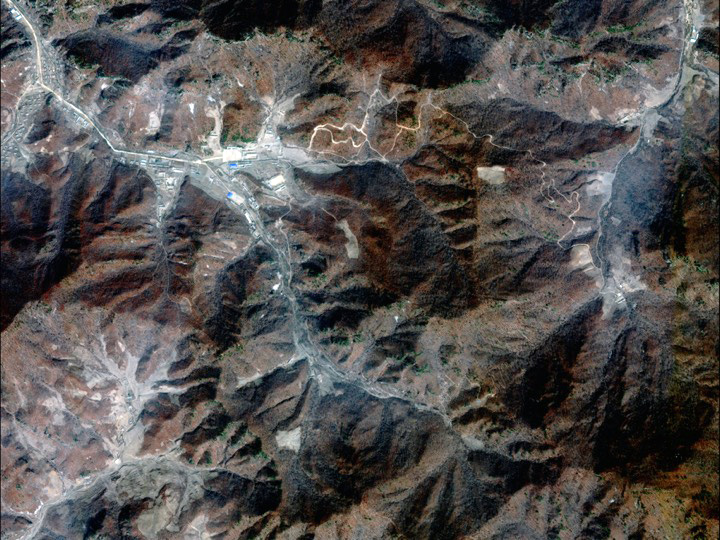
Undeclared North Korea: The Sakkanmol Missile Operating Base
Key Findings
- Sakkanmol (삭간몰) is an undeclared operational missile base for short-range ballistic missiles (SRBMs).
- It is one of 13, out of an estimated total of 20, undeclared North Korean missile operating bases identified by Beyond Parallel research.1
- Sakkanmol currently houses a unit equipped with SRBMs but could easily accommodate more capable medium-range ballistic missiles (MRBMs).
- The base is also one of the closest to the demilitarized zone (DMZ) and Seoul, giving it the shortest flight time.
- North Korea’s decommissioning of the Sohae satellite launch facility, while gaining much media attention, obscures the military threat to U.S. forces and South Korea from this and other undeclared ballistic missile bases.
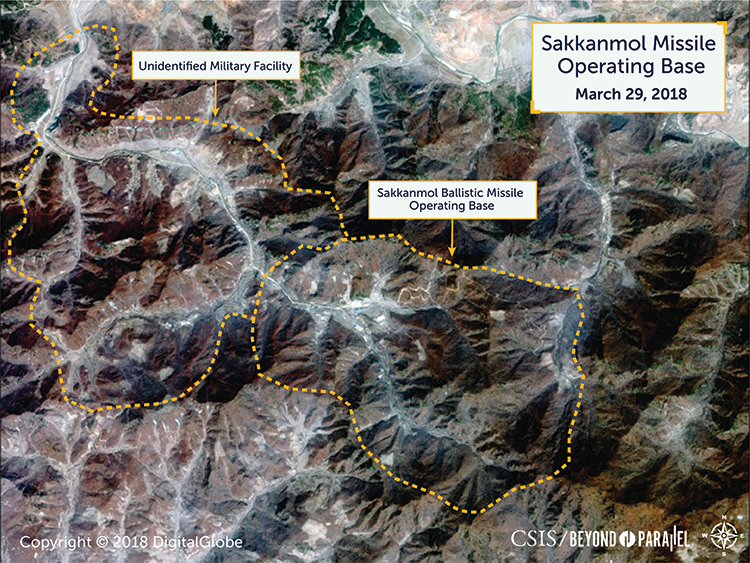
Overview of the Sakkanmol Missile Operating Base and adjacent unidentified military facility, March 29, 2018. (Copyright © 2018 by DigitalGlobe.)
Sakkanmol Missile Operating Base
Located within the Tactical Belt in North Hwanghae province, 85 km north of the DMZ and 135 km northwest of Seoul, the capital of South Korea, is the Sakkanmol missile operating base (38.584698° 126.107945°).2 Although occasionally and incorrectly referred to as an “underground missile storage” facility, it is a forward Hwasong-5/-6 missile operating base subordinate to the Strategic Force of the Korean People’s Army (KPA), which is responsible for all ballistic missile units.3 The base is located near the point where the three counties of Pongsan, Sohung, and Yontan in North Hwanghae province meet. Disambiguation of references to reported missile bases in these counties indicates that they are actually referring to the Sakkanmol missile operating base. This is likely true for references to a missile base at Togol, 9.5 km to the northeast (as opposed to To-gol 47 kilometers to the east), and may also be true for a reported ballistic missile unit in the Sariwon area, 31 km to the west.4
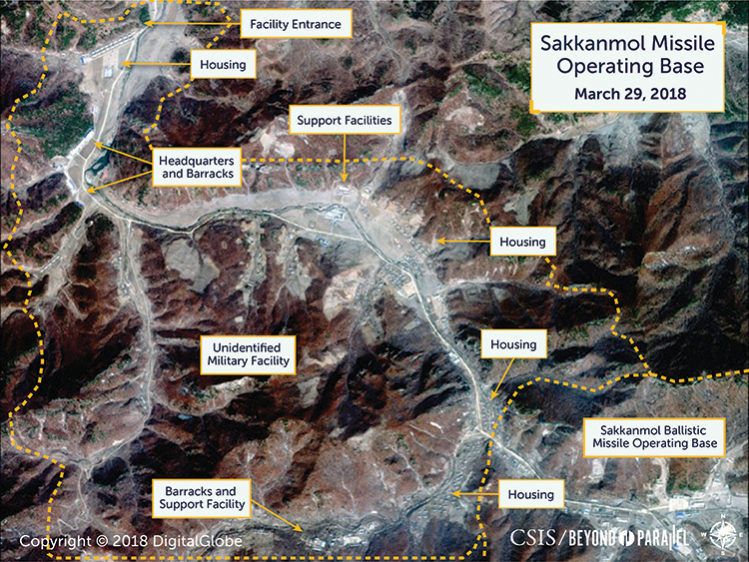
Overview of the unidentified military facility adjacent to the Sakkanmol Missile Operating Base, March 29, 2018. (Copyright © 2018 by DigitalGlobe.)
First phase construction of the Sakkanmol base began sometime between 1991 and 1993 using specialized engineering troops from KPA Unit No. 583 (the cover designator of the Military Construction Bureau).5 This initial phase of construction included the excavation of seven underground facilities and a drive-through missile support facility and the construction of a small number of barracks and support structures. The first phase was likely partially completed by September 1999.6
Reports from the following month suggest that Hwasong-6 missiles were planned for deployment at Sakkanmol and other Tactical Belt ballistic missile operating bases.7 Other reports from 1999 state that “North Korea is building underground launch pads and tunnels” at Sakkanmol; however, there is no evidence of this in any commercial satellite imagery and it is likely a mistaken description of the underground facilities at the base.8 In early 2001, the base was reportedly 90 percent completed and its final completion was anticipated by the end of the year.9
Beginning about 2004, the construction of an unidentified military facility with administration, barrack, housing, and support facilities began along the valley leading to the Sakkanmol base. The close proximity to the base—in fact one has to pass through this area to reach Sakkanmol—strongly suggests a relationship to the base and perhaps to the larger Tactical Belt. This relationship, if there is one, remains to be confirmed.10
Sometime in 2010 to 2011, a second phase of construction activity began at Sakkanmol that included the addition of barracks, vehicle maintenance and storage facilities, greenhouses, and a number of small structures throughout the base. After Kim Jong-un ascended to power in December 2011, he instituted widespread changes throughout the KPA emphasizing realistic training and increased operational readiness. These changes soon resulted in the reorganization of the Strategic Rocket Command into the Strategic Force in 2013 as well as significant infrastructure developments at a number of missile bases. At Sakkanmol, while these developments undoubtedly resulted in training and operational readiness improvements, only minor infrastructure changes were observed.
Satellite imagery since that time continues to show minor infrastructure changes to the base that are consistent with what is often seen at remote KPA bases of all types. As of November 2018, the base is active and being reasonably well-maintained by North Korean standards.
Organization
Encompassing approximately 7.8 km2, the Sakkanmol missile operating base extends 3.4 km up a small forked valley running first east along the Yongdanggae stream and then south past the tiny agricultural village of Sango-dong to the equally small village of Sakkanmol (from which it derives its name). Most of the area encompassed by the base consists of unoccupied mountains and small agricultural activities that support the base. It is unknown whether the military facilities and housing areas in the valley leading to the base are associated with it; if they are, it would increase the size of the base to approximately 12.5 km2.
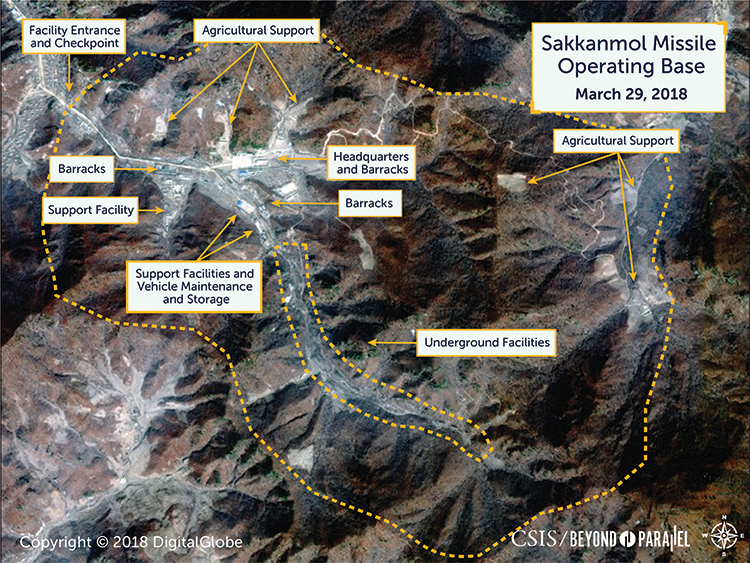
Overview of the Sakkanmol Missile Operating Base, March 29, 2018. (Copyright © 2018 by DigitalGlobe.)
The base can be functionally divided into four activities—agricultural support (including numerous greenhouses dispersed throughout the facility), main base (including headquarters, barracks, missile support, vehicle maintenance, storage, and a variety of small support elements), and underground and missile support facilities. 11 Located at the intersection of the eastern and southern branches of the valley is the main base.
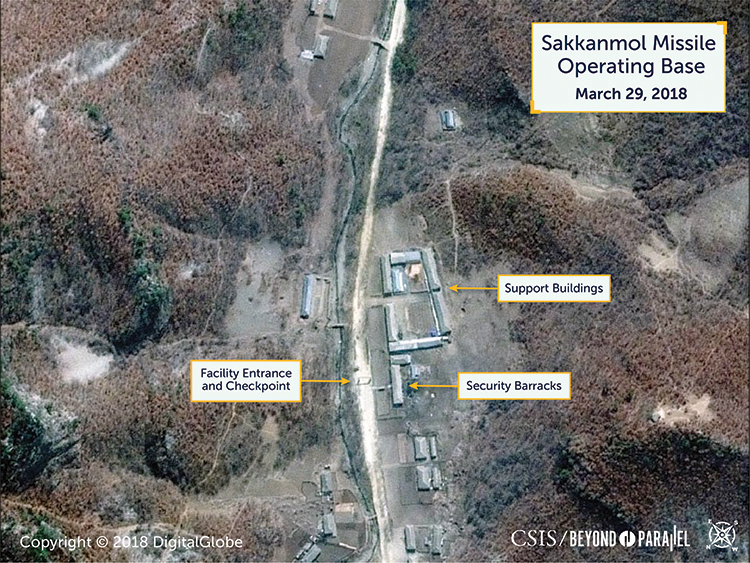
Entrance and security checkpoint of the Sakkanmol Missile Operating Base, March 29, 2018. (Copyright © 2018 by DigitalGlobe.)

Barracks and housing area just inside the base’s entrance. The presence of greenhouses and agricultural activities is typical of KPA bases, March 29, 2018. (Copyright © 2018 by DigitalGlobe.)

The headquarters and support area, showing the headquarters building, cultural hall administration and support buildings, and several miscellaneous support and agricultural facilities, March 29, 2018. (Copyright © 2018 by DigitalGlobe.)
Immediately to the west of the intersection are barracks, support and agricultural facilities, while to the east are the headquarters, a cultural hall, barracks, support and agricultural support structures, and a large parade ground.
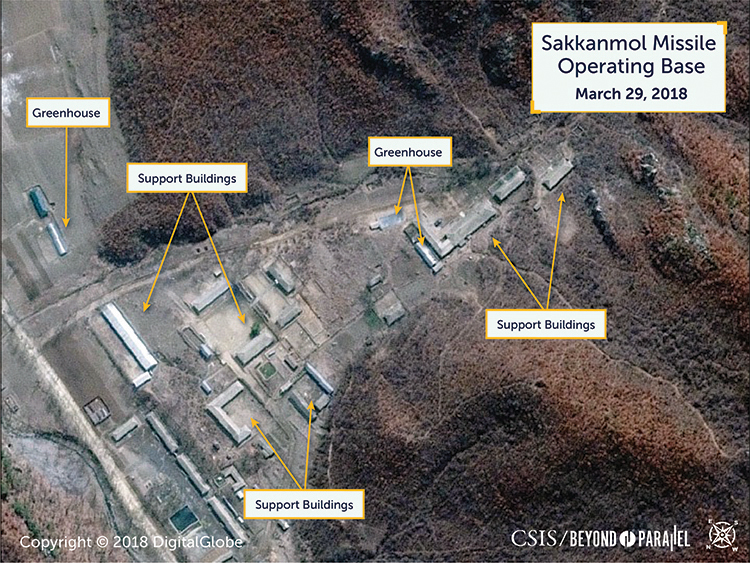
One of several support facilities within the base, March 29, 2018. (Copyright © 2018 by DigitalGlobe.)

Immediately south of the headquarters area are a number of barracks areas and a vehicle maintenance and storage facility, March 29, 2018. (Copyright © 2018 by DigitalGlobe.)
Spread out along the upper reaches of the base’s southern valley are entrances to seven underground facilities (UGFs), a barracks, and several small support facilities. The UGFs (38.572350° 126.116094°) are located on the east side of the valley in three groupings spaced approximately 400-500 meters apart. Each entrance is 6 to 7 meters wide and secured by two outward opening doors.
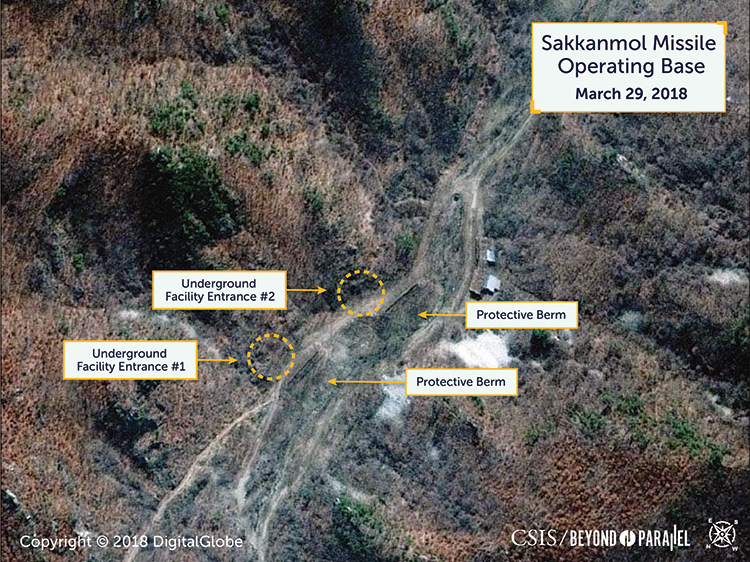
A view of the entrances to the #1 and #2 underground facilities. Visible in front of the entrances are large berms to protect the entrances from aerial and artillery attack, March 29, 2018. (Copyright © 2018 by DigitalGlobe.)
Approximately 13-20 meters in front of each entrance is a large rock and dirt berm built from the debris removed when excavating the UGFs. These berms are approximately 18-20 meters high, 55-65 meters long, and intended to protect the entrances from artillery fire and aerial attack. It is uncertain whether adjacent UGF tunnels in each grouping are internally connected so that vehicles (i.e., transporter-erector-launchers (TELs) or mobile-erector-launchers (MELs)) can drive through them. At a minimum, and following typical KPA practices, some are likely linked by small internally connected tunnels. The size of the entrances—as well as known KPA practices and the volume of soil removed—indicates that these tunnels could easily house all of the units TEL/MELs, reload vehicles, other technical vehicles, and supplies.
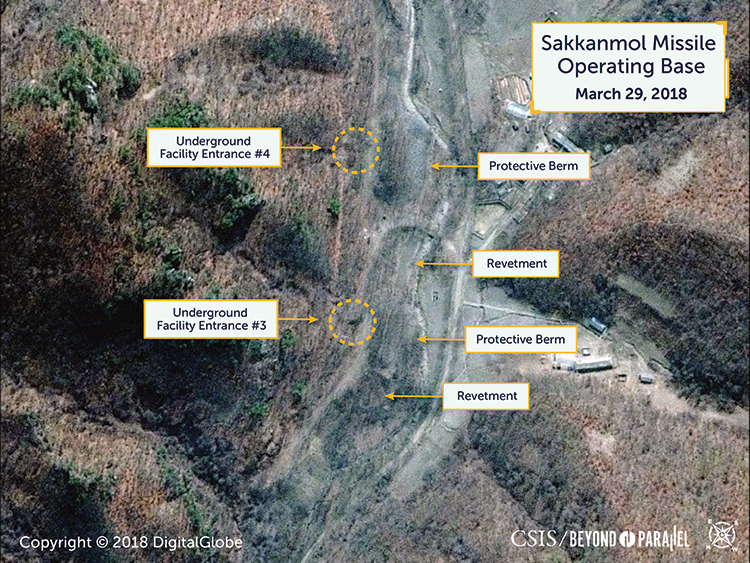
The entrances to the #3 and #4 underground facilities and their protective berms. Just barely visible are two large revetments adjacent to the berms. These revetments are large enough to support a missile launch in an emergency, March 29, 2018. (Copyright © 2018 by DigitalGlobe.)
There are two large revetments immediately outside UGF entrances #3 and #4. The purposes of these are unknown; however, they are large enough to support a missile launch in an emergency. Due to the UGF entrances’ location in a narrow tree-lined valley, they are frequently hidden from sight in satellite imagery during spring and summer, just visible during fall, and visible in winter after a snow fall—typically when viewed looking east.
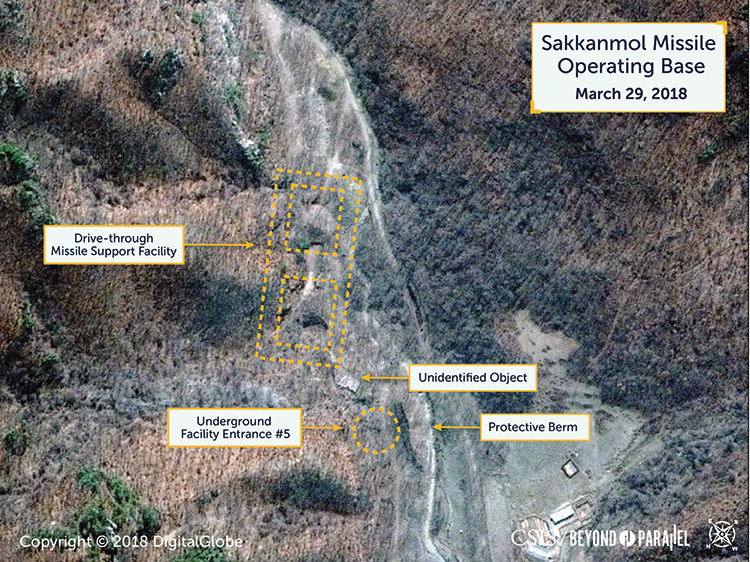
A view of the entrance to the #5 underground facility, its protective berm, and the drive-through missile support facility with its two earth covered shelters. There is an unidentified object between the entrance and support facility, March 29, 2018. (Copyright © 2018 by DigitalGlobe.)
The base’s missile support facility—used for arming, fueling, and maintenance operations—is located at the upper end of the valley immediately south of UGF entrance #5. It consists of a drive-through facility measuring approximately 95 meters by 10 to 15 meters with two approximately 25-meter-long earth-covered shelters separated by an open bay. It is unclear if there are additional entrances to the UGFs under these shelters, but this would not be unusual.
Reports since late 1999 indicate that the missile unit based at Sakkanmol is a regiment or brigade-sized unit consisting of three battalions with a total of 9-18 TELs/MELs, a headquarters, and organic support units.12
Most recently, on November 13, 2018 (KST), a spokesperson for South Korea’s Blue House stated, “I would like to tell you that the missile base at Sakkanmol is for short-range missiles like the ‘Scud’ or ‘Nodong (Rodong)’.” 13
Several observations from available satellite imagery support these reports, including:
- The size, number, and layout of the base’s buildings is similar to that of other known missile operating bases of approximately brigade size.
- The presence of seven entrances to UGFs that appear to be large enough to support a missile brigade’s equipment.
- The presence of a specialized drive-through ballistic missile support facility.
- What appears to be one or two MAZ-543 TELs under camouflaged tarps have occasionally been identified in satellite imagery in front of several of the UGF entrances.

The entrances to the #6 and #7 underground facilities and their protective berms, March 29, 2018. (Copyright © 2018 by DigitalGlobe.)
Research Note
This report is based upon an ongoing study of the Korean People’s Army ballistic missile infrastructure begun by one of the authors (Joseph Bermudez) in 1985, which itself is based upon numerous interviews with North Korean defectors and government, defense, and intelligence officials around the world. While some of the information used in the preparation of this study may eventually prove to be incomplete or incorrect, it is hoped that it provides a new and unique open-source look into the subject that others may build on. The information presented here supersedes or updates previous works by J. Bermudez on these subjects.
References
- This sentence was modified slightly for clarity on Nov. 13, 2018 at 4:14pm. ↩
- The national designator for the missile operating base at Sakkanmol is unknown and North Korea is not known to have ever made specific reference to its existence. The first reference to the use of the Sakkanmol designation known to the author occurred in the early 1990s during the author’s conversations with defense and intelligence officials. Subsequently, during the late 1990s, this designation began to appear in media reports concerning North Korean missile facilities. The transliteration of Korean place names into English is frequently challenging and often results in confusion and the Sakkanmol missile operating base is no exception to this phenomenon. Among the alternative transliterations for Sakkanmol are: Sagangmall, Satgatmol, Sakkan-mol, Sakken-mol, Sakkenmol, Saksan Mol, and Saksangmol. For consistency and ease of reading, this report uses U.S. National Geospatial-Intelligence Agency (NGA) accepted names for Sakkanmol and other places. ↩
- Author interview data; Yi Yo’ng-chong, “Taepo Dong-2 (Missile) Manufactured at Namp’o on Its Way in Camouflage to Launch Site,” JoongAng Ilbo, June 20, 2006; “ROK Weekly Views ROK-US ‘Perception Gap’ Toward DPRK Military,” Weekly Choson, April 10, 2001; “ROK Defense Ministry Claims DPRK Building Missile Power as World Debates US Plan,” JoongAng Ilbo, March 12, 2001, 2; and “ROK Daily Views DPRK Missile Buildup,” Kyonghyang Shinmun, March 4, 2001. ↩
- The name Togol is known to have been used in some declassified intelligence documents from the 1990s. Today, however, the facility is most often referred to as Sakkanmol. ↩
- Author interview data; Kang Ho-sik, “Increase in North Missiles,” Kyonghyang Shinmun, March 5, 2001; Osamu Eya, Great Illustrated Book of Kim Chong-il, (Tokyo: Shogakukan, 2000), 10-15; “Defector Says Long-Range Missile Bases Built,” KBS-1, August 24, 1993; and “Newspaper Reports North’s Scud Missile Deployment,” Seoul Shinmun, February 24, 1992, p. 8. ↩
- “Lawmaker: DPRK ‘Fully Prepared’ for Biological War,” Korea Times, September 29, 1999. ↩
- Chu Yong Chung, “North Korea Deploys Three Missiles Along the MDL,” Chosun Ilbo, September 29, 1999, 1; “N.K. Building Bases for Scud-C Missiles,” The Korea Herald, October 28, 1999; Hwang Yang-jun, “North Korea Builds Six Bases for 550 km-Range Missiles,” Hankook Ilbo, October 27, 1999; Kim Jong-hoon, “Announcement of the ’99 Defense White Paper – North Korean Troops Increased in Number to 1.17 Million,” Kyunghyang Shinmun, October 13, 1999; Kim Young-rep, “North, Holding 5,000 Tons of Chemical Weapons,” Munhwa Ilbo, October 13, 1999; and “Newspaper Reports North’s Scud Missile Deployment,” Seoul Shinmun, February 24, 1992, p. 8. ↩
- Hwang Yang-jun, “North Korea Builds Six Bases for 550 km-Range Missiles.” ↩
- Kang Ho-sik, “North Korea Constructs More Scud Missile Bases,” Kyonghyang Shinmun, March 4, 2001; Kang Ho-sik, “Increase in North Missiles,” Kyonghyang Shinmun, March 5, 2001; Kim Min Sok, “North Korea Continues to Expand Its Missile Base,” Joongang Ilbo, March 6, 2001; “Defense Ministry Silent Over Reports of DPRK’s Missile Buildup,” The Korea Herald, March 6, 2001; Yu Yong-won, “Pros and Cons of Sunshine Policy: ROK and United States ‘A World Apart’ on Assessments of North Korean Military Force,” Weekly Choson, April 10, 2001; “N.K. Building Bases for Scud-C Missiles,” The Korea Herald, October 28, 1999; “Pyongyang Beefs Up Artillery Near Demilitarized Zone,” Korea Times, October 28, 1999; and “Newspaper Reports North’s Scud Missile Deployment,” Seoul Shinmun, February 24, 1992, p. 8. ↩
- Author interview data. Among the potential relationships are a significant expansion of the missile unit at Sakkanmol or the establishment of a higher-level ballistic missile headquarters. ↩
- The greenhouses and agricultural support activities are not unusual within the KPA as all units have a varying level of responsibility for growing their own food. ↩
- Although the terms “regiment” and “brigade” are used here it should be noted that preliminary data suggests that KPA ballistic missile organizational structures do not necessarily fit neatly into Western organizational structures, may exhibit significant differences among units and that force structures have changed over time. Author interview data. In a 1994 unclassified assessment, the U.S. Defense Intelligence Agency credited a KPA Scud battalion with 173 personnel and 6 TELs. Defense Intelligence Agency. North Korea Handbook, 1993, 5-22. By comparison, Cold War-era Soviet Scud/Scaleboard brigades had a personnel strength of approximately 1,200 and 9 TELs. U.S. Army, Opposing Forces: Europe, FM 30-102, June 1, 1973, 13-6. ↩
- There is no official transcript from the Blue House to date, however, this quote was taken from the Blue House media team’s live-streaming website (https://www1.president.go.kr/articles/4827), quoting the spokesman’s press briefing on November 13, 2018 at timestamp 22:32. ↩
